Annotated Bibliography Assignment Solved
VerifiedAdded on 2020/12/31
|14
|3171
|308
AI Summary
Contribute Materials
Your contribution can guide someone’s learning journey. Share your
documents today.
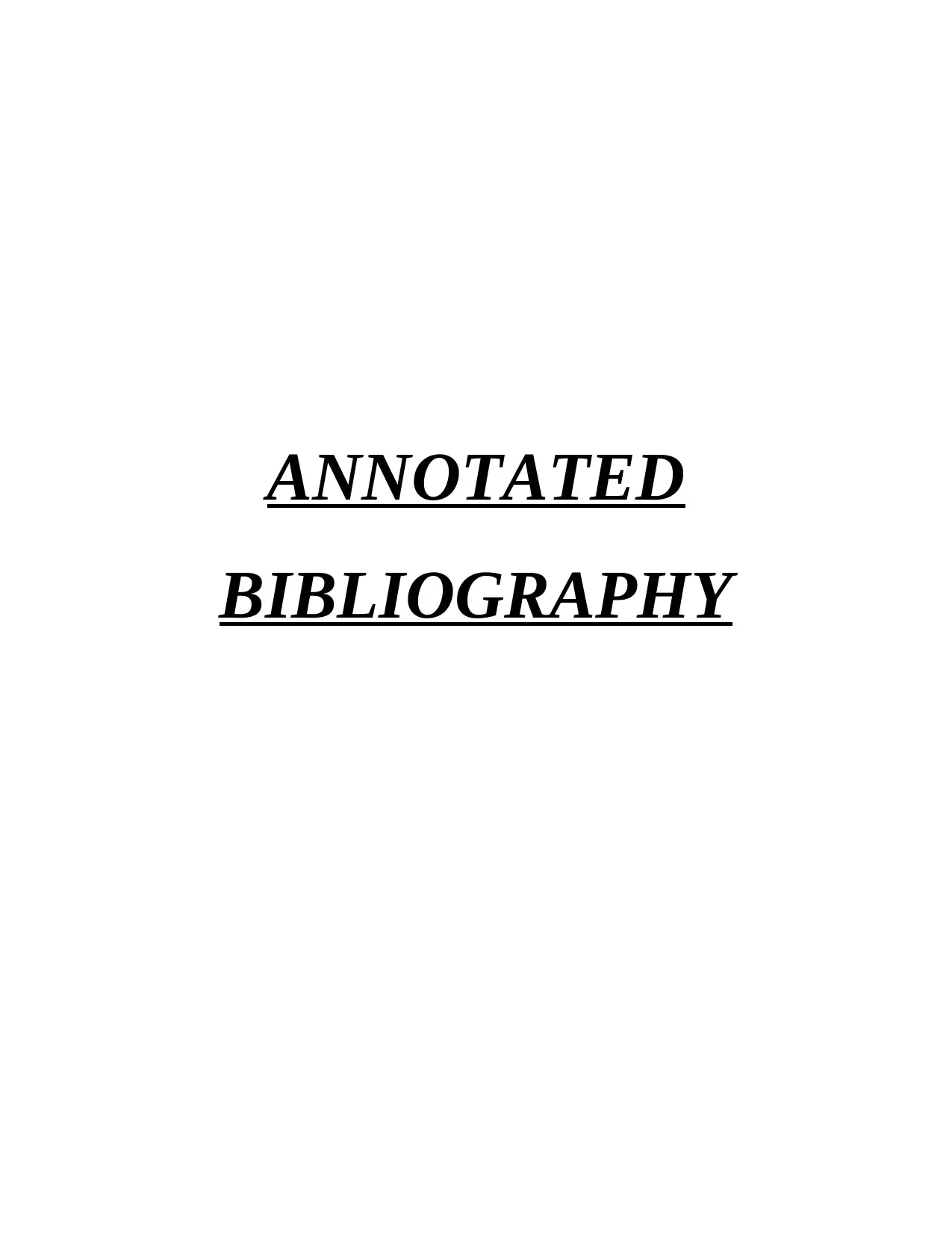
ANNOTATED
BIBLIOGRAPHY
BIBLIOGRAPHY
Secure Best Marks with AI Grader
Need help grading? Try our AI Grader for instant feedback on your assignments.
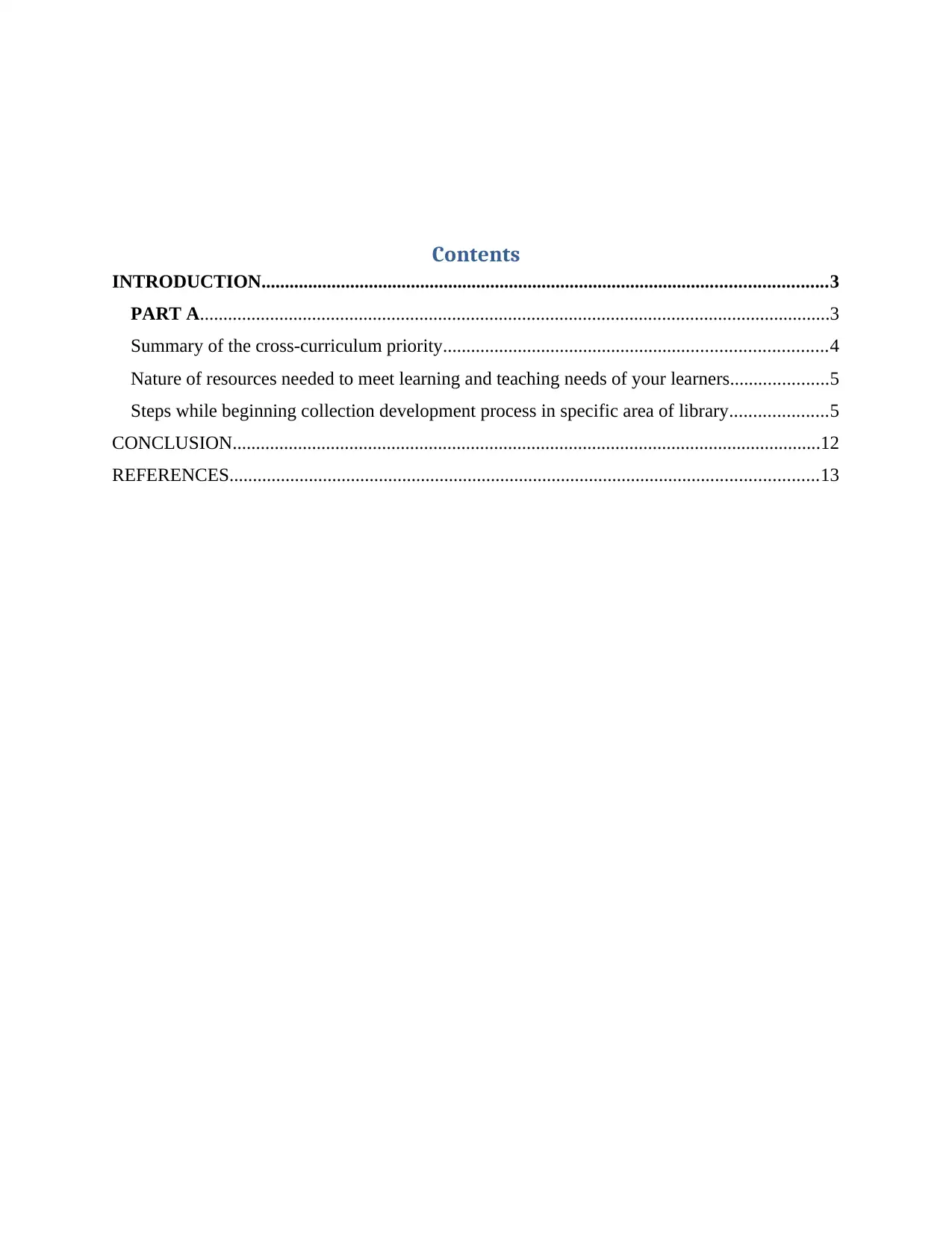
Contents
INTRODUCTION.........................................................................................................................3
PART A.......................................................................................................................................3
Summary of the cross-curriculum priority..................................................................................4
Nature of resources needed to meet learning and teaching needs of your learners.....................5
Steps while beginning collection development process in specific area of library.....................5
CONCLUSION..............................................................................................................................12
REFERENCES..............................................................................................................................13
INTRODUCTION.........................................................................................................................3
PART A.......................................................................................................................................3
Summary of the cross-curriculum priority..................................................................................4
Nature of resources needed to meet learning and teaching needs of your learners.....................5
Steps while beginning collection development process in specific area of library.....................5
CONCLUSION..............................................................................................................................12
REFERENCES..............................................................................................................................13

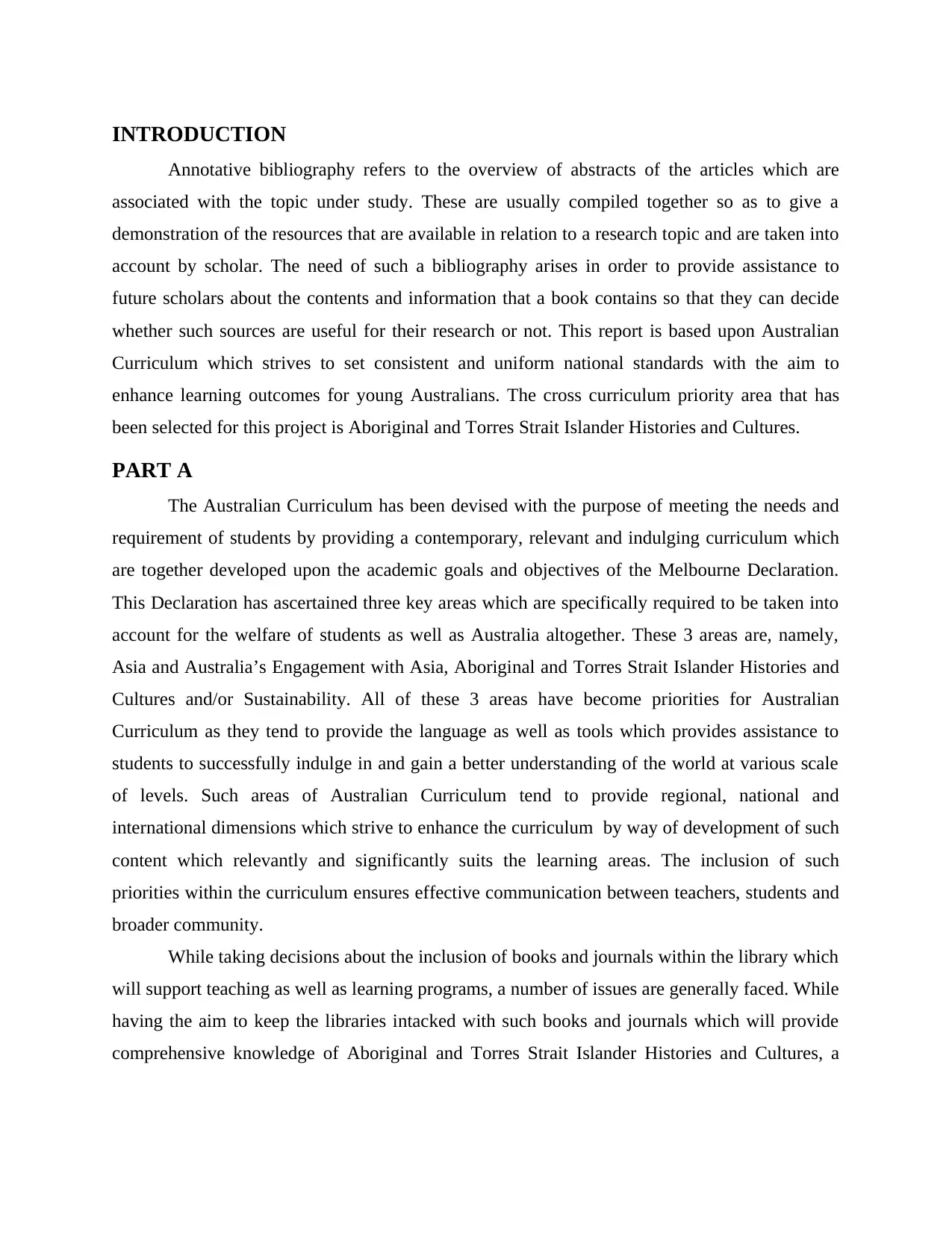
INTRODUCTION
Annotative bibliography refers to the overview of abstracts of the articles which are
associated with the topic under study. These are usually compiled together so as to give a
demonstration of the resources that are available in relation to a research topic and are taken into
account by scholar. The need of such a bibliography arises in order to provide assistance to
future scholars about the contents and information that a book contains so that they can decide
whether such sources are useful for their research or not. This report is based upon Australian
Curriculum which strives to set consistent and uniform national standards with the aim to
enhance learning outcomes for young Australians. The cross curriculum priority area that has
been selected for this project is Aboriginal and Torres Strait Islander Histories and Cultures.
PART A
The Australian Curriculum has been devised with the purpose of meeting the needs and
requirement of students by providing a contemporary, relevant and indulging curriculum which
are together developed upon the academic goals and objectives of the Melbourne Declaration.
This Declaration has ascertained three key areas which are specifically required to be taken into
account for the welfare of students as well as Australia altogether. These 3 areas are, namely,
Asia and Australia’s Engagement with Asia, Aboriginal and Torres Strait Islander Histories and
Cultures and/or Sustainability. All of these 3 areas have become priorities for Australian
Curriculum as they tend to provide the language as well as tools which provides assistance to
students to successfully indulge in and gain a better understanding of the world at various scale
of levels. Such areas of Australian Curriculum tend to provide regional, national and
international dimensions which strive to enhance the curriculum by way of development of such
content which relevantly and significantly suits the learning areas. The inclusion of such
priorities within the curriculum ensures effective communication between teachers, students and
broader community.
While taking decisions about the inclusion of books and journals within the library which
will support teaching as well as learning programs, a number of issues are generally faced. While
having the aim to keep the libraries intacked with such books and journals which will provide
comprehensive knowledge of Aboriginal and Torres Strait Islander Histories and Cultures, a
Annotative bibliography refers to the overview of abstracts of the articles which are
associated with the topic under study. These are usually compiled together so as to give a
demonstration of the resources that are available in relation to a research topic and are taken into
account by scholar. The need of such a bibliography arises in order to provide assistance to
future scholars about the contents and information that a book contains so that they can decide
whether such sources are useful for their research or not. This report is based upon Australian
Curriculum which strives to set consistent and uniform national standards with the aim to
enhance learning outcomes for young Australians. The cross curriculum priority area that has
been selected for this project is Aboriginal and Torres Strait Islander Histories and Cultures.
PART A
The Australian Curriculum has been devised with the purpose of meeting the needs and
requirement of students by providing a contemporary, relevant and indulging curriculum which
are together developed upon the academic goals and objectives of the Melbourne Declaration.
This Declaration has ascertained three key areas which are specifically required to be taken into
account for the welfare of students as well as Australia altogether. These 3 areas are, namely,
Asia and Australia’s Engagement with Asia, Aboriginal and Torres Strait Islander Histories and
Cultures and/or Sustainability. All of these 3 areas have become priorities for Australian
Curriculum as they tend to provide the language as well as tools which provides assistance to
students to successfully indulge in and gain a better understanding of the world at various scale
of levels. Such areas of Australian Curriculum tend to provide regional, national and
international dimensions which strive to enhance the curriculum by way of development of such
content which relevantly and significantly suits the learning areas. The inclusion of such
priorities within the curriculum ensures effective communication between teachers, students and
broader community.
While taking decisions about the inclusion of books and journals within the library which
will support teaching as well as learning programs, a number of issues are generally faced. While
having the aim to keep the libraries intacked with such books and journals which will provide
comprehensive knowledge of Aboriginal and Torres Strait Islander Histories and Cultures, a
Secure Best Marks with AI Grader
Need help grading? Try our AI Grader for instant feedback on your assignments.
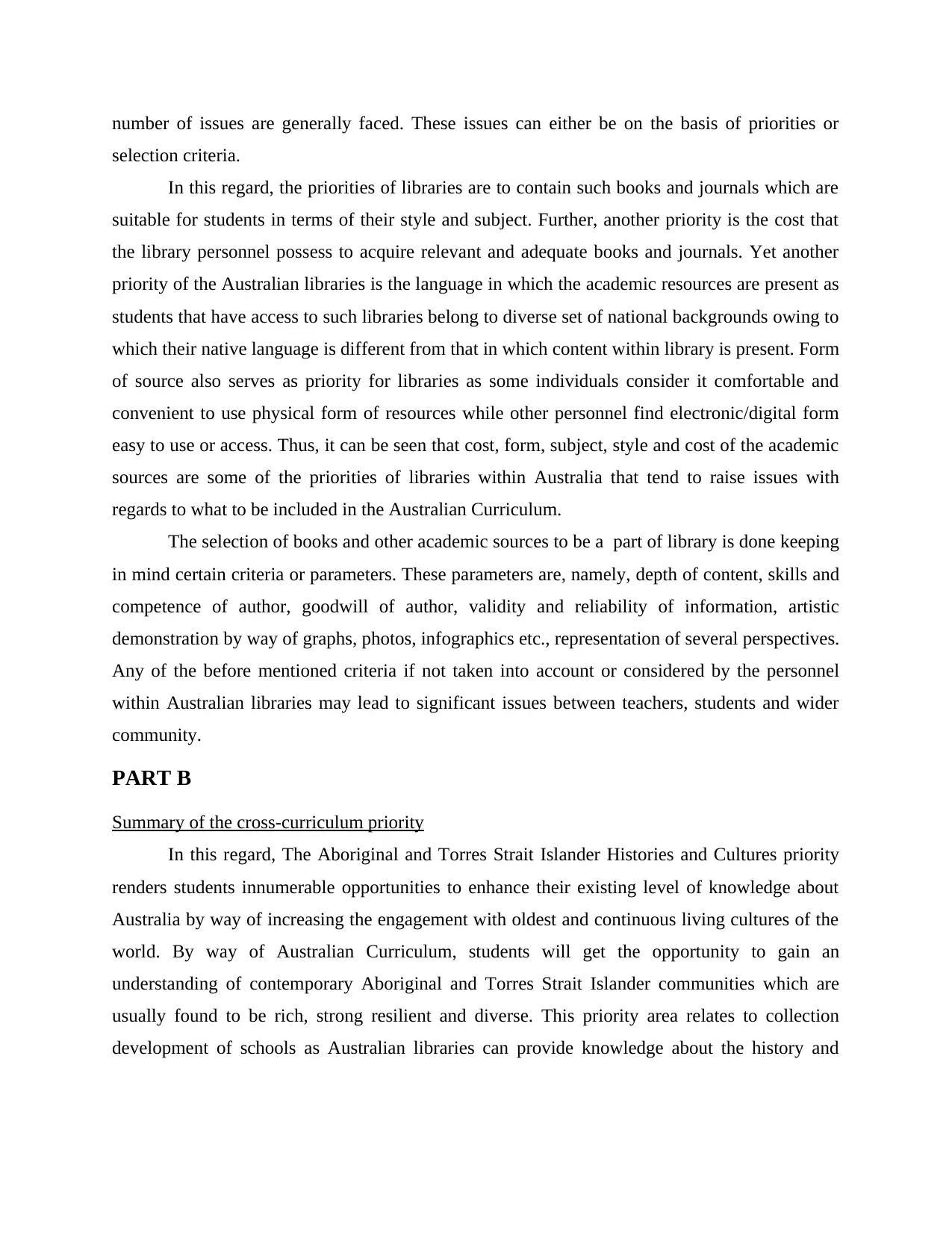
number of issues are generally faced. These issues can either be on the basis of priorities or
selection criteria.
In this regard, the priorities of libraries are to contain such books and journals which are
suitable for students in terms of their style and subject. Further, another priority is the cost that
the library personnel possess to acquire relevant and adequate books and journals. Yet another
priority of the Australian libraries is the language in which the academic resources are present as
students that have access to such libraries belong to diverse set of national backgrounds owing to
which their native language is different from that in which content within library is present. Form
of source also serves as priority for libraries as some individuals consider it comfortable and
convenient to use physical form of resources while other personnel find electronic/digital form
easy to use or access. Thus, it can be seen that cost, form, subject, style and cost of the academic
sources are some of the priorities of libraries within Australia that tend to raise issues with
regards to what to be included in the Australian Curriculum.
The selection of books and other academic sources to be a part of library is done keeping
in mind certain criteria or parameters. These parameters are, namely, depth of content, skills and
competence of author, goodwill of author, validity and reliability of information, artistic
demonstration by way of graphs, photos, infographics etc., representation of several perspectives.
Any of the before mentioned criteria if not taken into account or considered by the personnel
within Australian libraries may lead to significant issues between teachers, students and wider
community.
PART B
Summary of the cross-curriculum priority
In this regard, The Aboriginal and Torres Strait Islander Histories and Cultures priority
renders students innumerable opportunities to enhance their existing level of knowledge about
Australia by way of increasing the engagement with oldest and continuous living cultures of the
world. By way of Australian Curriculum, students will get the opportunity to gain an
understanding of contemporary Aboriginal and Torres Strait Islander communities which are
usually found to be rich, strong resilient and diverse. This priority area relates to collection
development of schools as Australian libraries can provide knowledge about the history and
selection criteria.
In this regard, the priorities of libraries are to contain such books and journals which are
suitable for students in terms of their style and subject. Further, another priority is the cost that
the library personnel possess to acquire relevant and adequate books and journals. Yet another
priority of the Australian libraries is the language in which the academic resources are present as
students that have access to such libraries belong to diverse set of national backgrounds owing to
which their native language is different from that in which content within library is present. Form
of source also serves as priority for libraries as some individuals consider it comfortable and
convenient to use physical form of resources while other personnel find electronic/digital form
easy to use or access. Thus, it can be seen that cost, form, subject, style and cost of the academic
sources are some of the priorities of libraries within Australia that tend to raise issues with
regards to what to be included in the Australian Curriculum.
The selection of books and other academic sources to be a part of library is done keeping
in mind certain criteria or parameters. These parameters are, namely, depth of content, skills and
competence of author, goodwill of author, validity and reliability of information, artistic
demonstration by way of graphs, photos, infographics etc., representation of several perspectives.
Any of the before mentioned criteria if not taken into account or considered by the personnel
within Australian libraries may lead to significant issues between teachers, students and wider
community.
PART B
Summary of the cross-curriculum priority
In this regard, The Aboriginal and Torres Strait Islander Histories and Cultures priority
renders students innumerable opportunities to enhance their existing level of knowledge about
Australia by way of increasing the engagement with oldest and continuous living cultures of the
world. By way of Australian Curriculum, students will get the opportunity to gain an
understanding of contemporary Aboriginal and Torres Strait Islander communities which are
usually found to be rich, strong resilient and diverse. This priority area relates to collection
development of schools as Australian libraries can provide knowledge about the history and

culture of Aboriginal and Torres Strait Islander communities only when the resources are
significant, adequate, valid and reliable
Nature of resources needed to meet learning and teaching needs of your learners
Almost all the libraries are posed to challenges and issues associated with identification,
acquisition and management of appropriate and relevant information resources. Traditional or
old formats along with the technologically engaging information resources are now being
expected by individuals within schools so that they can enhance their existing level of knowledge
and skills. The continuous changes taking place within formats of libraries, market models as
well as the trends in technologies have further enhance the expectations of students and thus
libraries now have to indulge in content development process so that they can fulfil the learning
needs and demands of learners in an effective manner. The Australian schools have the option to
include print and/or e-resources. Here, print resources comprise of books, encyclopedias,
dictionaries, journals and other necessary information providing material. The electronic
resources include sources of information such as e-books, e-journals, indexing and abstracting
database, numeric and statistical database, referencing database, e-images, full text databases, e-
audio, e-video etc. The resources that are made available within the libraries are of transient and
changing nature which reflects the need to update the resources at frequent intervals so that they
can match with the needs of learners. The sustainability considerations are thus on rise for
Australian schools in relation to libraries.
Steps while beginning collection development process in specific area of library
Collection Development policy assists the Australian schools in the process of collection
development through which libraries aim at procuring such resources which are capable of
providing knowledge and equipping students of information about The Aboriginal and Torres
Strait Islander Histories and Cultures. The contents and the ways in which Library collection
development policy is used by Australian schools are briefly stated below:-
Introduction: This part of the policy tens to give an explanation about the reason behind
writing the policy and also specifies who has written it. Also it gives a description of the
community which it strives to serve.
Philosophies and goal: The major objectives associated with the library as well as its
parent institution are clearly specified here.
significant, adequate, valid and reliable
Nature of resources needed to meet learning and teaching needs of your learners
Almost all the libraries are posed to challenges and issues associated with identification,
acquisition and management of appropriate and relevant information resources. Traditional or
old formats along with the technologically engaging information resources are now being
expected by individuals within schools so that they can enhance their existing level of knowledge
and skills. The continuous changes taking place within formats of libraries, market models as
well as the trends in technologies have further enhance the expectations of students and thus
libraries now have to indulge in content development process so that they can fulfil the learning
needs and demands of learners in an effective manner. The Australian schools have the option to
include print and/or e-resources. Here, print resources comprise of books, encyclopedias,
dictionaries, journals and other necessary information providing material. The electronic
resources include sources of information such as e-books, e-journals, indexing and abstracting
database, numeric and statistical database, referencing database, e-images, full text databases, e-
audio, e-video etc. The resources that are made available within the libraries are of transient and
changing nature which reflects the need to update the resources at frequent intervals so that they
can match with the needs of learners. The sustainability considerations are thus on rise for
Australian schools in relation to libraries.
Steps while beginning collection development process in specific area of library
Collection Development policy assists the Australian schools in the process of collection
development through which libraries aim at procuring such resources which are capable of
providing knowledge and equipping students of information about The Aboriginal and Torres
Strait Islander Histories and Cultures. The contents and the ways in which Library collection
development policy is used by Australian schools are briefly stated below:-
Introduction: This part of the policy tens to give an explanation about the reason behind
writing the policy and also specifies who has written it. Also it gives a description of the
community which it strives to serve.
Philosophies and goal: The major objectives associated with the library as well as its
parent institution are clearly specified here.
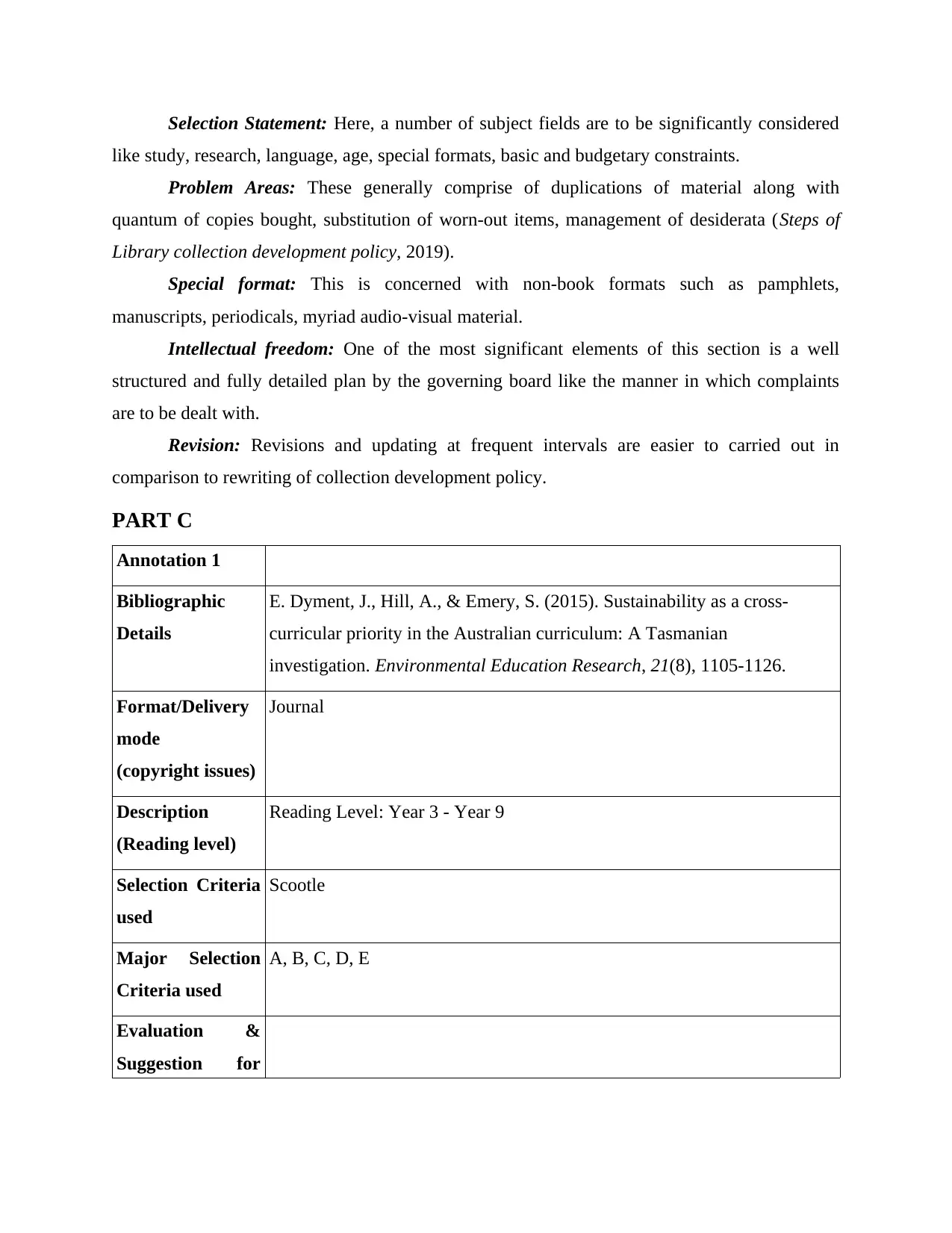
Selection Statement: Here, a number of subject fields are to be significantly considered
like study, research, language, age, special formats, basic and budgetary constraints.
Problem Areas: These generally comprise of duplications of material along with
quantum of copies bought, substitution of worn-out items, management of desiderata (Steps of
Library collection development policy, 2019).
Special format: This is concerned with non-book formats such as pamphlets,
manuscripts, periodicals, myriad audio-visual material.
Intellectual freedom: One of the most significant elements of this section is a well
structured and fully detailed plan by the governing board like the manner in which complaints
are to be dealt with.
Revision: Revisions and updating at frequent intervals are easier to carried out in
comparison to rewriting of collection development policy.
PART C
Annotation 1
Bibliographic
Details
E. Dyment, J., Hill, A., & Emery, S. (2015). Sustainability as a cross-
curricular priority in the Australian curriculum: A Tasmanian
investigation. Environmental Education Research, 21(8), 1105-1126.
Format/Delivery
mode
(copyright issues)
Journal
Description
(Reading level)
Reading Level: Year 3 - Year 9
Selection Criteria
used
Scootle
Major Selection
Criteria used
A, B, C, D, E
Evaluation &
Suggestion for
like study, research, language, age, special formats, basic and budgetary constraints.
Problem Areas: These generally comprise of duplications of material along with
quantum of copies bought, substitution of worn-out items, management of desiderata (Steps of
Library collection development policy, 2019).
Special format: This is concerned with non-book formats such as pamphlets,
manuscripts, periodicals, myriad audio-visual material.
Intellectual freedom: One of the most significant elements of this section is a well
structured and fully detailed plan by the governing board like the manner in which complaints
are to be dealt with.
Revision: Revisions and updating at frequent intervals are easier to carried out in
comparison to rewriting of collection development policy.
PART C
Annotation 1
Bibliographic
Details
E. Dyment, J., Hill, A., & Emery, S. (2015). Sustainability as a cross-
curricular priority in the Australian curriculum: A Tasmanian
investigation. Environmental Education Research, 21(8), 1105-1126.
Format/Delivery
mode
(copyright issues)
Journal
Description
(Reading level)
Reading Level: Year 3 - Year 9
Selection Criteria
used
Scootle
Major Selection
Criteria used
A, B, C, D, E
Evaluation &
Suggestion for
Paraphrase This Document
Need a fresh take? Get an instant paraphrase of this document with our AI Paraphraser
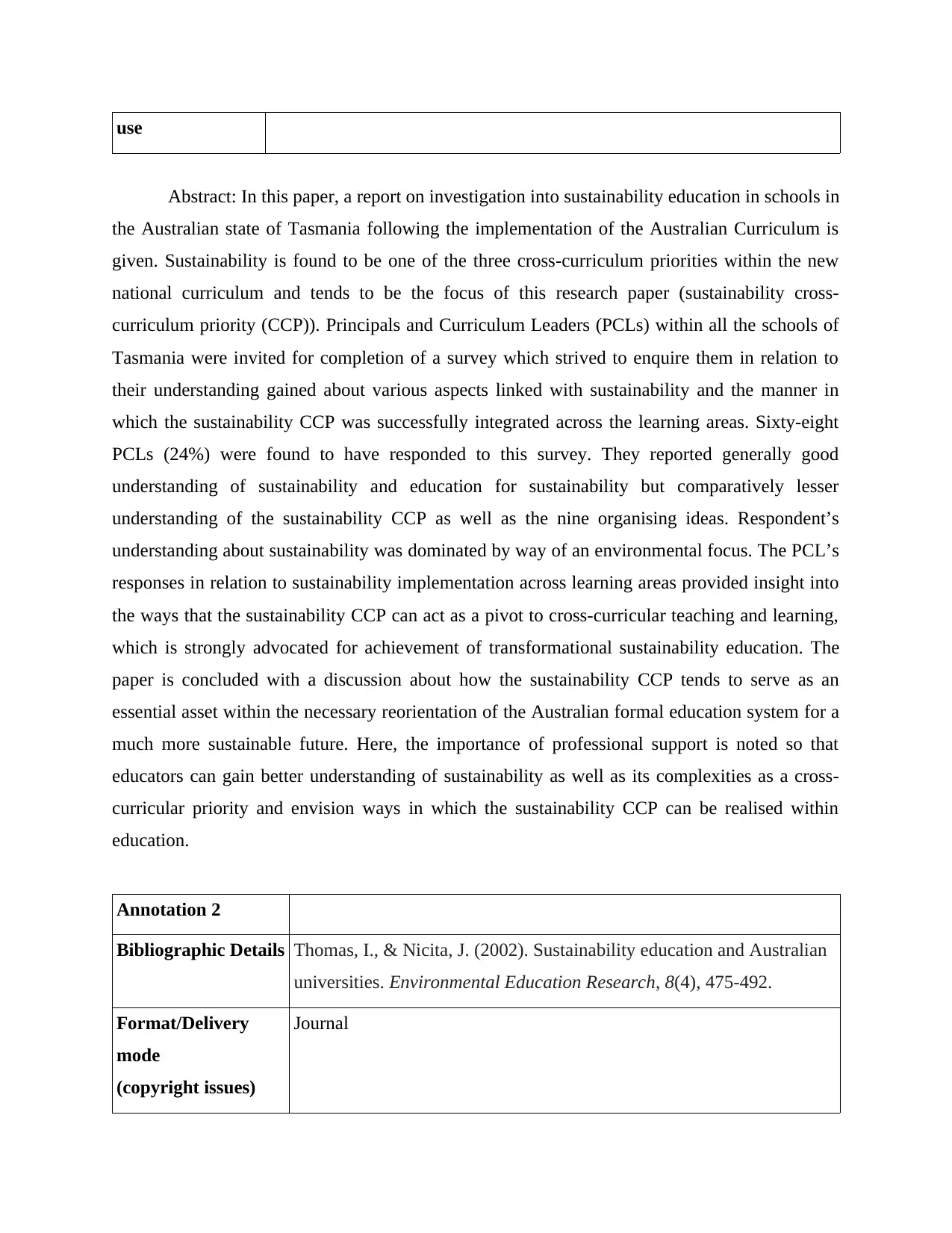
use
Abstract: In this paper, a report on investigation into sustainability education in schools in
the Australian state of Tasmania following the implementation of the Australian Curriculum is
given. Sustainability is found to be one of the three cross-curriculum priorities within the new
national curriculum and tends to be the focus of this research paper (sustainability cross-
curriculum priority (CCP)). Principals and Curriculum Leaders (PCLs) within all the schools of
Tasmania were invited for completion of a survey which strived to enquire them in relation to
their understanding gained about various aspects linked with sustainability and the manner in
which the sustainability CCP was successfully integrated across the learning areas. Sixty-eight
PCLs (24%) were found to have responded to this survey. They reported generally good
understanding of sustainability and education for sustainability but comparatively lesser
understanding of the sustainability CCP as well as the nine organising ideas. Respondent’s
understanding about sustainability was dominated by way of an environmental focus. The PCL’s
responses in relation to sustainability implementation across learning areas provided insight into
the ways that the sustainability CCP can act as a pivot to cross-curricular teaching and learning,
which is strongly advocated for achievement of transformational sustainability education. The
paper is concluded with a discussion about how the sustainability CCP tends to serve as an
essential asset within the necessary reorientation of the Australian formal education system for a
much more sustainable future. Here, the importance of professional support is noted so that
educators can gain better understanding of sustainability as well as its complexities as a cross-
curricular priority and envision ways in which the sustainability CCP can be realised within
education.
Annotation 2
Bibliographic Details Thomas, I., & Nicita, J. (2002). Sustainability education and Australian
universities. Environmental Education Research, 8(4), 475-492.
Format/Delivery
mode
(copyright issues)
Journal
Abstract: In this paper, a report on investigation into sustainability education in schools in
the Australian state of Tasmania following the implementation of the Australian Curriculum is
given. Sustainability is found to be one of the three cross-curriculum priorities within the new
national curriculum and tends to be the focus of this research paper (sustainability cross-
curriculum priority (CCP)). Principals and Curriculum Leaders (PCLs) within all the schools of
Tasmania were invited for completion of a survey which strived to enquire them in relation to
their understanding gained about various aspects linked with sustainability and the manner in
which the sustainability CCP was successfully integrated across the learning areas. Sixty-eight
PCLs (24%) were found to have responded to this survey. They reported generally good
understanding of sustainability and education for sustainability but comparatively lesser
understanding of the sustainability CCP as well as the nine organising ideas. Respondent’s
understanding about sustainability was dominated by way of an environmental focus. The PCL’s
responses in relation to sustainability implementation across learning areas provided insight into
the ways that the sustainability CCP can act as a pivot to cross-curricular teaching and learning,
which is strongly advocated for achievement of transformational sustainability education. The
paper is concluded with a discussion about how the sustainability CCP tends to serve as an
essential asset within the necessary reorientation of the Australian formal education system for a
much more sustainable future. Here, the importance of professional support is noted so that
educators can gain better understanding of sustainability as well as its complexities as a cross-
curricular priority and envision ways in which the sustainability CCP can be realised within
education.
Annotation 2
Bibliographic Details Thomas, I., & Nicita, J. (2002). Sustainability education and Australian
universities. Environmental Education Research, 8(4), 475-492.
Format/Delivery
mode
(copyright issues)
Journal
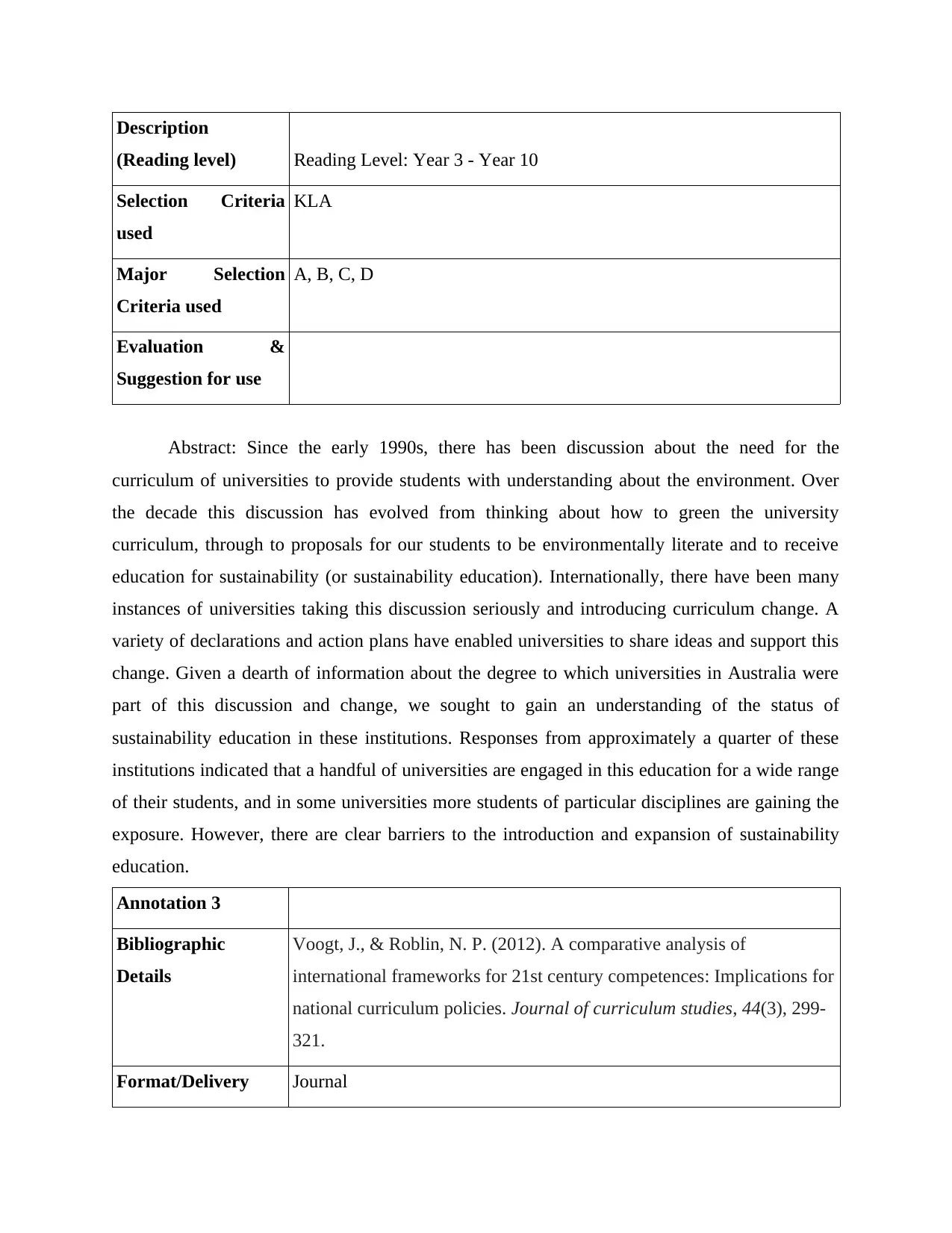
Description
(Reading level) Reading Level: Year 3 - Year 10
Selection Criteria
used
KLA
Major Selection
Criteria used
A, B, C, D
Evaluation &
Suggestion for use
Abstract: Since the early 1990s, there has been discussion about the need for the
curriculum of universities to provide students with understanding about the environment. Over
the decade this discussion has evolved from thinking about how to green the university
curriculum, through to proposals for our students to be environmentally literate and to receive
education for sustainability (or sustainability education). Internationally, there have been many
instances of universities taking this discussion seriously and introducing curriculum change. A
variety of declarations and action plans have enabled universities to share ideas and support this
change. Given a dearth of information about the degree to which universities in Australia were
part of this discussion and change, we sought to gain an understanding of the status of
sustainability education in these institutions. Responses from approximately a quarter of these
institutions indicated that a handful of universities are engaged in this education for a wide range
of their students, and in some universities more students of particular disciplines are gaining the
exposure. However, there are clear barriers to the introduction and expansion of sustainability
education.
Annotation 3
Bibliographic
Details
Voogt, J., & Roblin, N. P. (2012). A comparative analysis of
international frameworks for 21st century competences: Implications for
national curriculum policies. Journal of curriculum studies, 44(3), 299-
321.
Format/Delivery Journal
(Reading level) Reading Level: Year 3 - Year 10
Selection Criteria
used
KLA
Major Selection
Criteria used
A, B, C, D
Evaluation &
Suggestion for use
Abstract: Since the early 1990s, there has been discussion about the need for the
curriculum of universities to provide students with understanding about the environment. Over
the decade this discussion has evolved from thinking about how to green the university
curriculum, through to proposals for our students to be environmentally literate and to receive
education for sustainability (or sustainability education). Internationally, there have been many
instances of universities taking this discussion seriously and introducing curriculum change. A
variety of declarations and action plans have enabled universities to share ideas and support this
change. Given a dearth of information about the degree to which universities in Australia were
part of this discussion and change, we sought to gain an understanding of the status of
sustainability education in these institutions. Responses from approximately a quarter of these
institutions indicated that a handful of universities are engaged in this education for a wide range
of their students, and in some universities more students of particular disciplines are gaining the
exposure. However, there are clear barriers to the introduction and expansion of sustainability
education.
Annotation 3
Bibliographic
Details
Voogt, J., & Roblin, N. P. (2012). A comparative analysis of
international frameworks for 21st century competences: Implications for
national curriculum policies. Journal of curriculum studies, 44(3), 299-
321.
Format/Delivery Journal
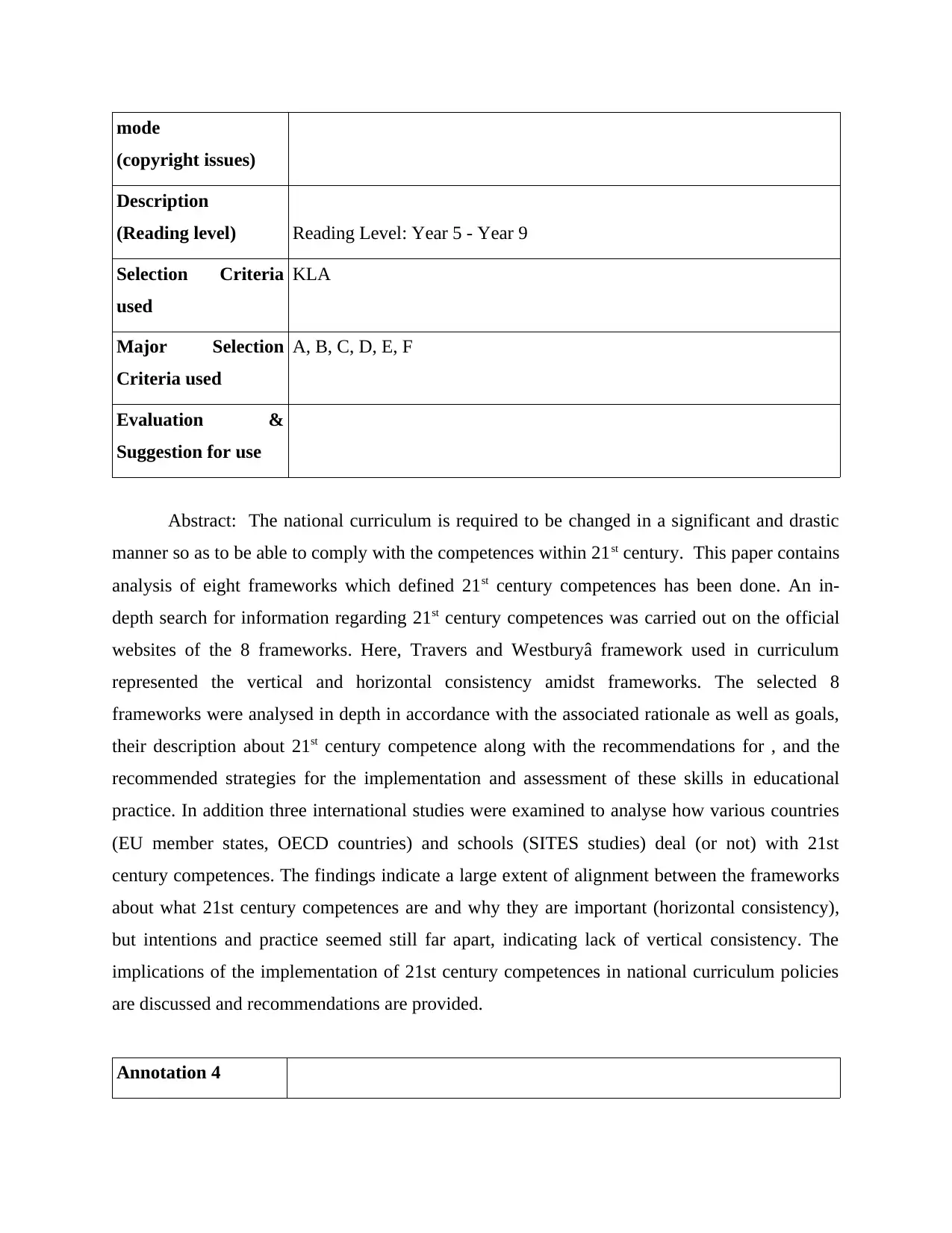
mode
(copyright issues)
Description
(Reading level) Reading Level: Year 5 - Year 9
Selection Criteria
used
KLA
Major Selection
Criteria used
A, B, C, D, E, F
Evaluation &
Suggestion for use
Abstract: The national curriculum is required to be changed in a significant and drastic
manner so as to be able to comply with the competences within 21st century. This paper contains
analysis of eight frameworks which defined 21st century competences has been done. An in-
depth search for information regarding 21st century competences was carried out on the official
websites of the 8 frameworks. Here, Travers and Westburyâ framework used in curriculum
represented the vertical and horizontal consistency amidst frameworks. The selected 8
frameworks were analysed in depth in accordance with the associated rationale as well as goals,
their description about 21st century competence along with the recommendations for , and the
recommended strategies for the implementation and assessment of these skills in educational
practice. In addition three international studies were examined to analyse how various countries
(EU member states, OECD countries) and schools (SITES studies) deal (or not) with 21st
century competences. The findings indicate a large extent of alignment between the frameworks
about what 21st century competences are and why they are important (horizontal consistency),
but intentions and practice seemed still far apart, indicating lack of vertical consistency. The
implications of the implementation of 21st century competences in national curriculum policies
are discussed and recommendations are provided.
Annotation 4
(copyright issues)
Description
(Reading level) Reading Level: Year 5 - Year 9
Selection Criteria
used
KLA
Major Selection
Criteria used
A, B, C, D, E, F
Evaluation &
Suggestion for use
Abstract: The national curriculum is required to be changed in a significant and drastic
manner so as to be able to comply with the competences within 21st century. This paper contains
analysis of eight frameworks which defined 21st century competences has been done. An in-
depth search for information regarding 21st century competences was carried out on the official
websites of the 8 frameworks. Here, Travers and Westburyâ framework used in curriculum
represented the vertical and horizontal consistency amidst frameworks. The selected 8
frameworks were analysed in depth in accordance with the associated rationale as well as goals,
their description about 21st century competence along with the recommendations for , and the
recommended strategies for the implementation and assessment of these skills in educational
practice. In addition three international studies were examined to analyse how various countries
(EU member states, OECD countries) and schools (SITES studies) deal (or not) with 21st
century competences. The findings indicate a large extent of alignment between the frameworks
about what 21st century competences are and why they are important (horizontal consistency),
but intentions and practice seemed still far apart, indicating lack of vertical consistency. The
implications of the implementation of 21st century competences in national curriculum policies
are discussed and recommendations are provided.
Annotation 4
Secure Best Marks with AI Grader
Need help grading? Try our AI Grader for instant feedback on your assignments.
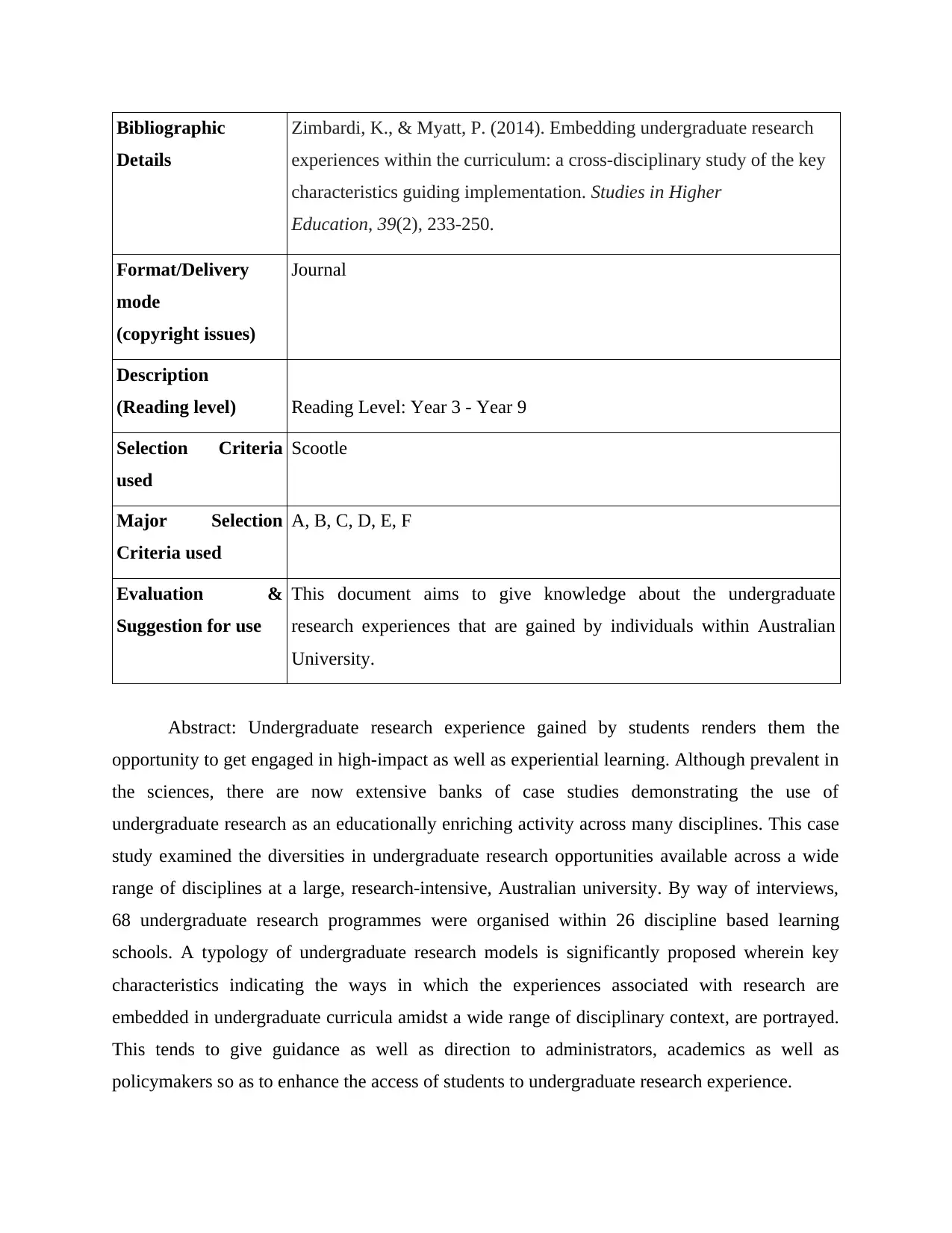
Bibliographic
Details
Zimbardi, K., & Myatt, P. (2014). Embedding undergraduate research
experiences within the curriculum: a cross-disciplinary study of the key
characteristics guiding implementation. Studies in Higher
Education, 39(2), 233-250.
Format/Delivery
mode
(copyright issues)
Journal
Description
(Reading level) Reading Level: Year 3 - Year 9
Selection Criteria
used
Scootle
Major Selection
Criteria used
A, B, C, D, E, F
Evaluation &
Suggestion for use
This document aims to give knowledge about the undergraduate
research experiences that are gained by individuals within Australian
University.
Abstract: Undergraduate research experience gained by students renders them the
opportunity to get engaged in high-impact as well as experiential learning. Although prevalent in
the sciences, there are now extensive banks of case studies demonstrating the use of
undergraduate research as an educationally enriching activity across many disciplines. This case
study examined the diversities in undergraduate research opportunities available across a wide
range of disciplines at a large, research-intensive, Australian university. By way of interviews,
68 undergraduate research programmes were organised within 26 discipline based learning
schools. A typology of undergraduate research models is significantly proposed wherein key
characteristics indicating the ways in which the experiences associated with research are
embedded in undergraduate curricula amidst a wide range of disciplinary context, are portrayed.
This tends to give guidance as well as direction to administrators, academics as well as
policymakers so as to enhance the access of students to undergraduate research experience.
Details
Zimbardi, K., & Myatt, P. (2014). Embedding undergraduate research
experiences within the curriculum: a cross-disciplinary study of the key
characteristics guiding implementation. Studies in Higher
Education, 39(2), 233-250.
Format/Delivery
mode
(copyright issues)
Journal
Description
(Reading level) Reading Level: Year 3 - Year 9
Selection Criteria
used
Scootle
Major Selection
Criteria used
A, B, C, D, E, F
Evaluation &
Suggestion for use
This document aims to give knowledge about the undergraduate
research experiences that are gained by individuals within Australian
University.
Abstract: Undergraduate research experience gained by students renders them the
opportunity to get engaged in high-impact as well as experiential learning. Although prevalent in
the sciences, there are now extensive banks of case studies demonstrating the use of
undergraduate research as an educationally enriching activity across many disciplines. This case
study examined the diversities in undergraduate research opportunities available across a wide
range of disciplines at a large, research-intensive, Australian university. By way of interviews,
68 undergraduate research programmes were organised within 26 discipline based learning
schools. A typology of undergraduate research models is significantly proposed wherein key
characteristics indicating the ways in which the experiences associated with research are
embedded in undergraduate curricula amidst a wide range of disciplinary context, are portrayed.
This tends to give guidance as well as direction to administrators, academics as well as
policymakers so as to enhance the access of students to undergraduate research experience.

Annotation 5
Bibliographic
Details
Aikenhead, G. (2001). Integrating Western and Aboriginal sciences:
Cross-cultural science teaching. Research in Science Education, 31(3),
337-355.
Format/Delivery
mode
(copyright issues)
Description
(Reading level) Reading Level: Year 4 - Year 9
Selection Criteria
used
Scootle
Major Selection
Criteria used
A, B, C, D, E, F
Evaluation &
Suggestion for use
This information can be used to gain knowledge about the privileges
that are being enjoyed by Aboriginal students in day to day learning
process.
Abstract: This article seeks to address the challenges faced by privileges enjoyed by
aboriginal students. Firstly, a rationale is provided for carrying out cross culture education
associated with science specially dedicated for students to gain individual meanings from their
science platforms. Then a practical research and development project is laid out which
demonstrates cross cultural teaching in case of science for the years 6 – 11 where Western and
Aboriginal sciences are feasibly integrated.
Bibliographic
Details
Aikenhead, G. (2001). Integrating Western and Aboriginal sciences:
Cross-cultural science teaching. Research in Science Education, 31(3),
337-355.
Format/Delivery
mode
(copyright issues)
Description
(Reading level) Reading Level: Year 4 - Year 9
Selection Criteria
used
Scootle
Major Selection
Criteria used
A, B, C, D, E, F
Evaluation &
Suggestion for use
This information can be used to gain knowledge about the privileges
that are being enjoyed by Aboriginal students in day to day learning
process.
Abstract: This article seeks to address the challenges faced by privileges enjoyed by
aboriginal students. Firstly, a rationale is provided for carrying out cross culture education
associated with science specially dedicated for students to gain individual meanings from their
science platforms. Then a practical research and development project is laid out which
demonstrates cross cultural teaching in case of science for the years 6 – 11 where Western and
Aboriginal sciences are feasibly integrated.
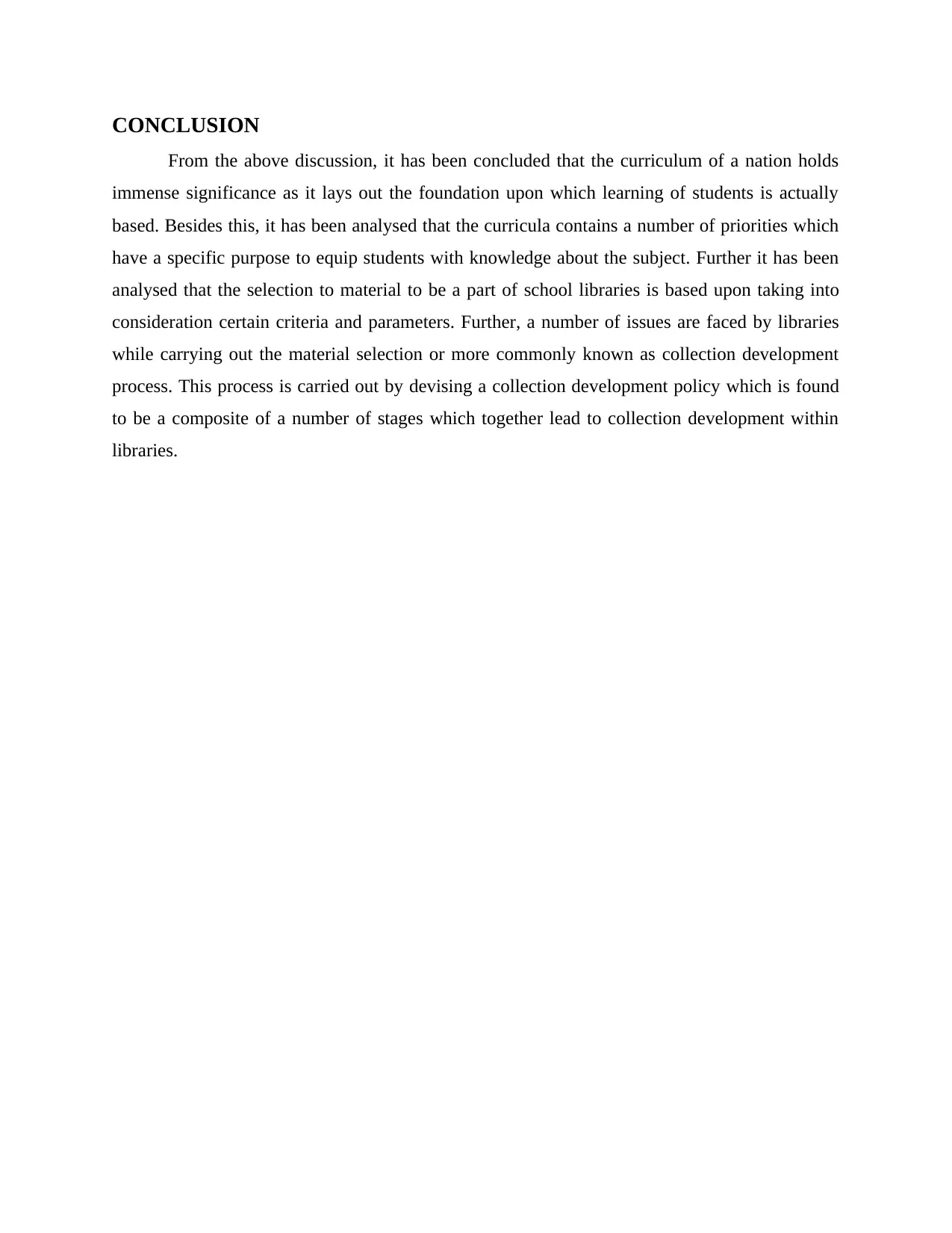
CONCLUSION
From the above discussion, it has been concluded that the curriculum of a nation holds
immense significance as it lays out the foundation upon which learning of students is actually
based. Besides this, it has been analysed that the curricula contains a number of priorities which
have a specific purpose to equip students with knowledge about the subject. Further it has been
analysed that the selection to material to be a part of school libraries is based upon taking into
consideration certain criteria and parameters. Further, a number of issues are faced by libraries
while carrying out the material selection or more commonly known as collection development
process. This process is carried out by devising a collection development policy which is found
to be a composite of a number of stages which together lead to collection development within
libraries.
From the above discussion, it has been concluded that the curriculum of a nation holds
immense significance as it lays out the foundation upon which learning of students is actually
based. Besides this, it has been analysed that the curricula contains a number of priorities which
have a specific purpose to equip students with knowledge about the subject. Further it has been
analysed that the selection to material to be a part of school libraries is based upon taking into
consideration certain criteria and parameters. Further, a number of issues are faced by libraries
while carrying out the material selection or more commonly known as collection development
process. This process is carried out by devising a collection development policy which is found
to be a composite of a number of stages which together lead to collection development within
libraries.
Paraphrase This Document
Need a fresh take? Get an instant paraphrase of this document with our AI Paraphraser
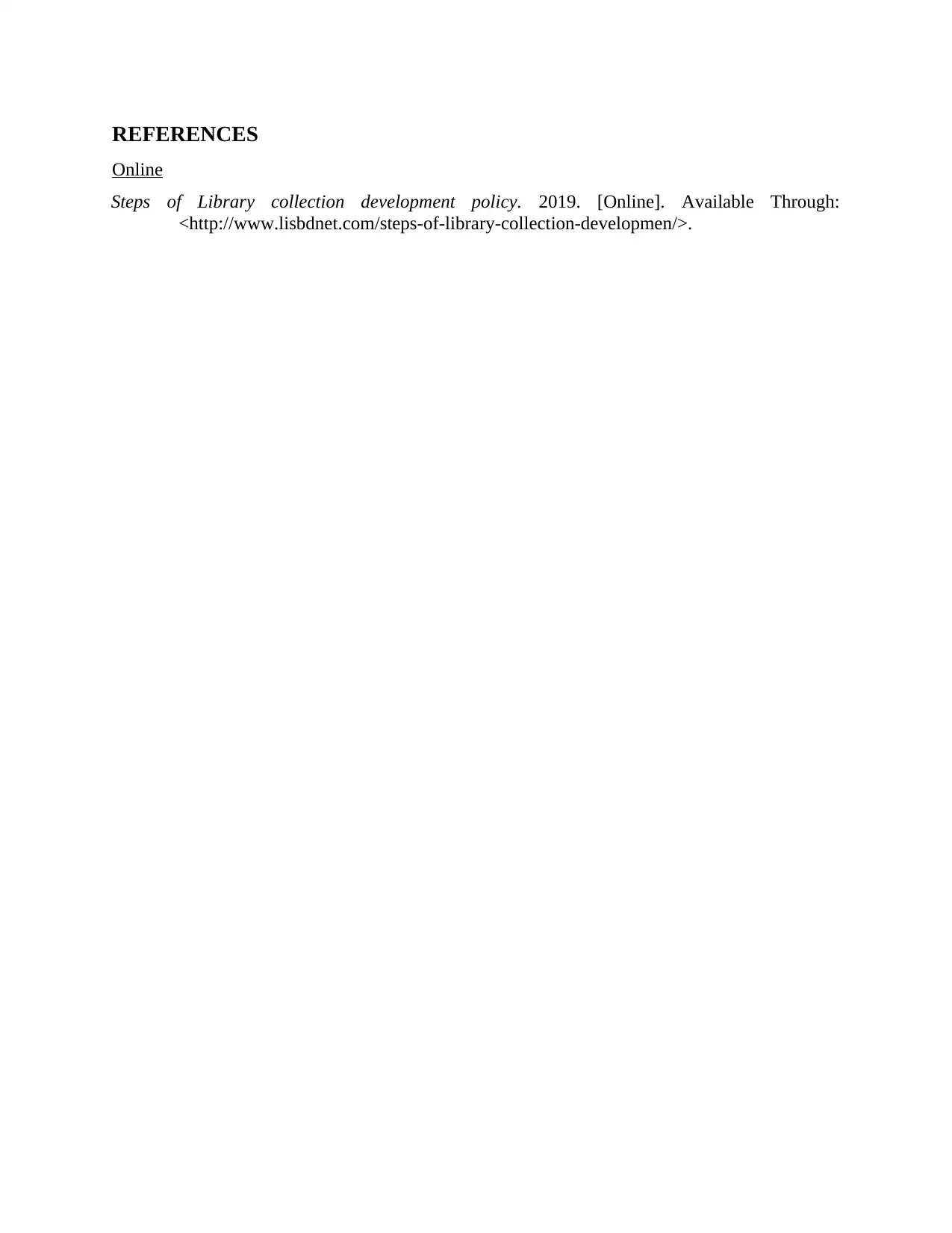
REFERENCES
Online
Steps of Library collection development policy. 2019. [Online]. Available Through:
<http://www.lisbdnet.com/steps-of-library-collection-developmen/>.
Online
Steps of Library collection development policy. 2019. [Online]. Available Through:
<http://www.lisbdnet.com/steps-of-library-collection-developmen/>.
1 out of 14
Related Documents
Your All-in-One AI-Powered Toolkit for Academic Success.
+13062052269
info@desklib.com
Available 24*7 on WhatsApp / Email
![[object Object]](/_next/static/media/star-bottom.7253800d.svg)
Unlock your academic potential
© 2024 | Zucol Services PVT LTD | All rights reserved.





